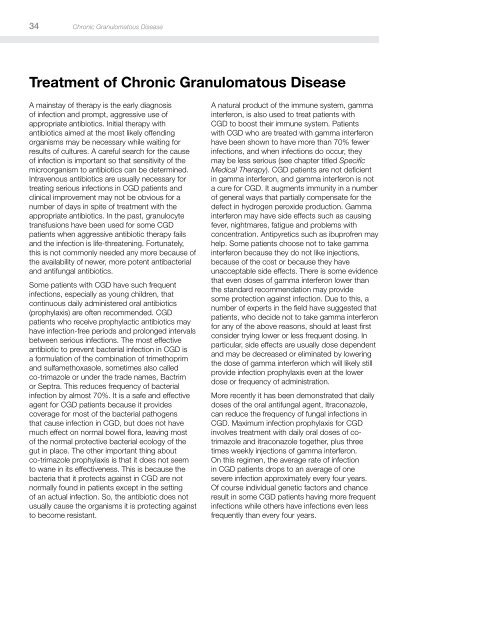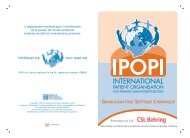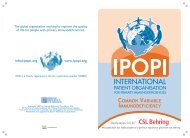IDF Patient & Family Handbook for Primary Immunodeficiency ... - IDFA
IDF Patient & Family Handbook for Primary Immunodeficiency ... - IDFA
IDF Patient & Family Handbook for Primary Immunodeficiency ... - IDFA
Create successful ePaper yourself
Turn your PDF publications into a flip-book with our unique Google optimized e-Paper software.
34 Chronic Granulomatous Disease<br />
Treatment of Chronic Granulomatous Disease<br />
A mainstay of therapy is the early diagnosis<br />
of infection and prompt, aggressive use of<br />
appropriate antibiotics. Initial therapy with<br />
antibiotics aimed at the most likely offending<br />
organisms may be necessary while waiting <strong>for</strong><br />
results of cultures. A careful search <strong>for</strong> the cause<br />
of infection is important so that sensitivity of the<br />
microorganism to antibiotics can be determined.<br />
Intravenous antibiotics are usually necessary <strong>for</strong><br />
treating serious infections in CGD patients and<br />
clinical improvement may not be obvious <strong>for</strong> a<br />
number of days in spite of treatment with the<br />
appropriate antibiotics. In the past, granulocyte<br />
transfusions have been used <strong>for</strong> some CGD<br />
patients when aggressive antibiotic therapy fails<br />
and the infection is life-threatening. Fortunately,<br />
this is not commonly needed any more because of<br />
the availability of newer, more potent antibacterial<br />
and antifungal antibiotics.<br />
Some patients with CGD have such frequent<br />
infections, especially as young children, that<br />
continuous daily administered oral antibiotics<br />
(prophylaxis) are often recommended. CGD<br />
patients who receive prophylactic antibiotics may<br />
have infection-free periods and prolonged intervals<br />
between serious infections. The most effective<br />
antibiotic to prevent bacterial infection in CGD is<br />
a <strong>for</strong>mulation of the combination of trimethoprim<br />
and sulfamethoxasole, sometimes also called<br />
co-trimazole or under the trade names, Bactrim<br />
or Septra. This reduces frequency of bacterial<br />
infection by almost 70%. It is a safe and effective<br />
agent <strong>for</strong> CGD patients because it provides<br />
coverage <strong>for</strong> most of the bacterial pathogens<br />
that cause infection in CGD, but does not have<br />
much effect on normal bowel flora, leaving most<br />
of the normal protective bacterial ecology of the<br />
gut in place. The other important thing about<br />
co-trimazole prophylaxis is that it does not seem<br />
to wane in its effectiveness. This is because the<br />
bacteria that it protects against in CGD are not<br />
normally found in patients except in the setting<br />
of an actual infection. So, the antibiotic does not<br />
usually cause the organisms it is protecting against<br />
to become resistant.<br />
A natural product of the immune system, gamma<br />
interferon, is also used to treat patients with<br />
CGD to boost their immune system. <strong>Patient</strong>s<br />
with CGD who are treated with gamma interferon<br />
have been shown to have more than 70% fewer<br />
infections, and when infections do occur, they<br />
may be less serious (see chapter titled Specific<br />
Medical Therapy). CGD patients are not deficient<br />
in gamma interferon, and gamma interferon is not<br />
a cure <strong>for</strong> CGD. It augments immunity in a number<br />
of general ways that partially compensate <strong>for</strong> the<br />
defect in hydrogen peroxide production. Gamma<br />
interferon may have side effects such as causing<br />
fever, nightmares, fatigue and problems with<br />
concentration. Antipyretics such as ibuprofren may<br />
help. Some patients choose not to take gamma<br />
interferon because they do not like injections,<br />
because of the cost or because they have<br />
unacceptable side effects. There is some evidence<br />
that even doses of gamma interferon lower than<br />
the standard recommendation may provide<br />
some protection against infection. Due to this, a<br />
number of experts in the field have suggested that<br />
patients, who decide not to take gamma interferon<br />
<strong>for</strong> any of the above reasons, should at least first<br />
consider trying lower or less frequent dosing. In<br />
particular, side effects are usually dose dependent<br />
and may be decreased or eliminated by lowering<br />
the dose of gamma interferon which will likely still<br />
provide infection prophylaxis even at the lower<br />
dose or frequency of administration.<br />
More recently it has been demonstrated that daily<br />
doses of the oral antifungal agent, Itraconazole,<br />
can reduce the frequency of fungal infections in<br />
CGD. Maximum infection prophylaxis <strong>for</strong> CGD<br />
involves treatment with daily oral doses of cotrimazole<br />
and itraconazole together, plus three<br />
times weekly injections of gamma interferon.<br />
On this regimen, the average rate of infection<br />
in CGD patients drops to an average of one<br />
severe infection approximately every four years.<br />
Of course individual genetic factors and chance<br />
result in some CGD patients having more frequent<br />
infections while others have infections even less<br />
frequently than every four years.
















